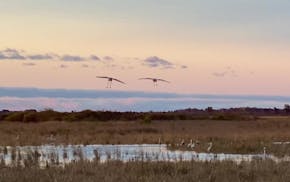Even though the weather warmed early this spring, turf-grass experts cautioned us to wait to start in on our lawns. Fertilizing, seeding and applying weed control when the soil temperatures were too low would be a waste of time and money. Wait, they advised.
Well, now the waiting is over. It's time to feed, get after those weeds and seed thin areas.
Fertilizing
The grass is actively growing now, so actively that you've probably had to mow once or twice. That means it's now able to use the added nutrients in a fertilizer.
Apply fertilizer when a light rainfall is expected, or water the lawn lightly after you fertilize so the product reaches the soil, and eventually, the roots.
Be sure to sweep up any fertilizer granules that land on sidewalks or driveways to prevent them from washing into streets and storm sewers, polluting our lakes and rivers.
Weed control
Pre-emergent herbicides kill weed seeds as they germinate, which is happening now. If you use weed control, target areas where crabgrass or other annual weeds have been a problem in past years. It's wasteful and unnecessary to spread herbicides over areas that haven't been weedy.
If you'd like to use organic weed controls, choose corn gluten meal. In addition to stopping weed seeds, corn gluten meal also feeds the lawn by providing nitrogen. Though it's initially less effective than other herbicides, results improve each year when corn gluten meal is applied in spring and late summer for several years.
Keep in mind, the vast majority of pre-emergent herbicides can't discriminate between weed seeds and grass seeds. So don't "seed and weed" at the same time unless you use a weed-control product labeled specifically for use on newly seeded lawns.
Dandelions and other perennial broad-leaf weeds are a different story. Their roots survive from year to year, so there's little value in trying to prevent their seeds from sprouting. Instead of using a product that contains both fertilizer and herbicide, you can target perennial weeds such as dandelions by spraying them with a broad-leaf herbicide.
Broad-leaf herbicides should be used with caution in spring because there's so much young, vulnerable growth in the landscape that could be injured by drift or careless spraying. You can skip herbicides altogether by digging out perennial weeds with a narrow trowel or a dandelion digger. They come out fairly easily when the soil is damp.
Seeding
In Minnesota, spring is the second-best time to plant grass seed. (The best time is early autumn, when the nights are growing longer and temperatures are dropping.)
If you need to seed an area where the grass is thin, use a heavy metal garden rake to rough up the area, so seeds make good contact with the soil. Add fertilizer when you plant, then water the area lightly but frequently to keep it moist. If your soil is very compacted, consider having it aerated before spreading seed and fertilizer.
One warning: Roughing up the soil to plant seeds will likely bring up weed seeds sitting in the soil, so consider applying a pre-emergent herbicide labeled for newly seeded lawns. Otherwise you could end up with a new weed patch.
Don't use broad-leaf herbicides on a newly seeded lawn, though. Wait until fall.
Deb Brown is a garden writer and former extension horticulturist with the University of Minnesota. To ask her a gardening question, call 612-673-7793 and leave a message. She will answer questions in this column only.

A Minnesota field guide to snow shovels: Which one's best?
Sign up for Star Tribune newsletters

